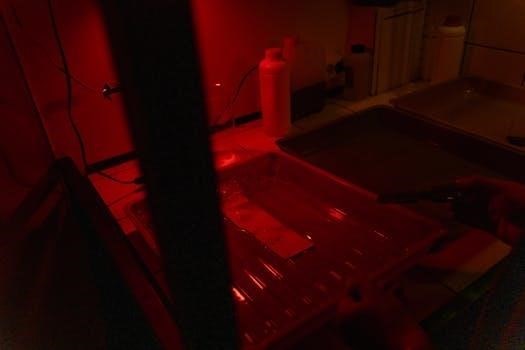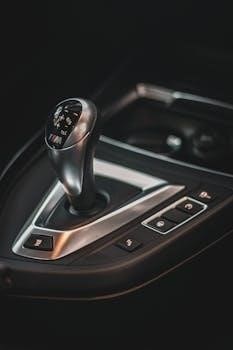Manual Gearbox Stop Leak⁚ A Comprehensive Guide
Manual gearbox leaks can lead to significant issues, potentially causing complete transmission failure. Identifying the cause promptly is vital, whether it’s gasket failure, worn seals, or other problems. This guide offers comprehensive insights into diagnosing and addressing these leaks effectively, ensuring your vehicle’s longevity and preventing accidents.
Common Causes of Manual Gearbox Leaks
Several factors can contribute to manual gearbox leaks, with gasket failure being the most prevalent. The gasket ensures a tight seal between the gearbox and engine, as well as the output shafts. Over time, friction, pressure, and heat degrade these gaskets, leading to leaks. Worn seals are another common cause, deteriorating with normal use and age, causing cracks and loss of sealing ability.
Bearing problems can also indirectly cause leaks. Worn or damaged bearings affect shaft and gear alignment, stressing seals. Overfilling the gearbox is yet another culprit. Excess fluid creates pressure, forcing oil past seals and gaskets. Loose plugs and bolts, often after fluid changes, can also result in leakage if not properly tightened. Internal pressure imbalances, where internal pressure exceeds external pressure, force oil out.

Lack of or incorrect lubrication can also contribute to leaks. Improper lubrication leads to increased friction and heat, accelerating wear on seals and gaskets. Each of these causes necessitates prompt attention to prevent further gearbox damage and maintain optimal vehicle performance.
Identifying the Source of the Leak
Pinpointing the exact source of a manual gearbox leak is crucial for effective repair. Start by visually inspecting the area around the gearbox. Look for telltale signs of oil accumulation or drips beneath the vehicle, particularly after it has been parked for a while. Gearbox lube is heavy weight, so even a small leak may leave a visible residue. Check the rear seal, side plates, and the speedometer cable attachment for signs of leakage.

Clean the gearbox exterior thoroughly to remove existing oil, making it easier to spot fresh leaks. After cleaning, drive the vehicle briefly and re-inspect the gearbox. Examine the areas where the gearbox connects to the engine and output shafts. Pay close attention to gaskets and seals, as these are common failure points. Also, check the drain plug and bolts for tightness. Over-tightening can also cause leaks by stripping the threads.
If the leak is at the top of the gearbox, inspect the ventilation hole and any connections around the 4WD selector, if applicable. Remember that leaks can also stem from axle seals. Thoroughly checking all potential sources will guide you to the appropriate repair.
Gasket Failure⁚ The Primary Culprit
Gasket failure stands out as the most frequent cause of manual transmission fluid leaks. Gaskets are essential components, forming seals between the gearbox and the engine, as well as between the gearbox and the output shafts. These seals prevent fluid from escaping, maintaining optimal lubrication and pressure within the transmission system. Over time, the friction, pressure, and heat generated inside the transmission gradually wear down these gaskets.
The constant exposure to transmission fluid, combined with temperature fluctuations, can cause gaskets to become brittle, cracked, or deformed. Once a gasket loses its integrity, it can no longer maintain a tight seal, leading to fluid leakage. Identifying a failed gasket often involves visually inspecting the mating surfaces between the gearbox and other components for signs of oil seepage.
In some cases, the transmission light may illuminate, indicating low fluid levels or abnormal transmission behavior. Addressing gasket failure promptly is critical to prevent further damage to the transmission and ensure safe vehicle operation. Ignoring a leaking gasket can lead to costly repairs or even transmission failure.
Worn Seals and Gaskets⁚ Deterioration Over Time
Over extended use, the seals and gaskets within a manual transmission undergo natural deterioration. These components, typically made of rubber or similar materials, are susceptible to wear and tear due to constant exposure to heat, pressure, and transmission fluid. As time passes, the seals and gaskets gradually lose their elasticity and become prone to cracking or hardening. This deterioration compromises their ability to maintain a tight seal, leading to fluid leakage.
Factors such as temperature fluctuations and chemical reactions with the transmission fluid can accelerate the aging process. In particular, extreme heat cycles can cause the seals to become brittle and lose their original shape, creating gaps that allow fluid to escape. Additionally, contaminants in the transmission fluid can erode the surface of the seals, further diminishing their effectiveness.
Regular inspection of the transmission for signs of oil seepage is crucial in detecting worn seals and gaskets. Addressing these issues promptly can prevent more significant damage and ensure the proper functioning of the manual gearbox. Replacing worn seals and gaskets is a routine maintenance procedure that can extend the lifespan of the transmission and maintain its performance.
Bearing Problems and Their Impact on Seals
Worn or damaged bearings within a manual transmission can indirectly cause leaks by putting undue stress on the surrounding seals. Bearings are crucial for maintaining the correct alignment and smooth rotation of shafts and gears. When bearings fail, they allow excessive play or movement, leading to vibrations and misalignment within the transmission.

This misalignment can place additional strain on the seals that are designed to keep the transmission fluid contained. The seals are not designed to withstand constant flexing or movement, and the added stress can cause them to wear out prematurely. The resulting gaps or cracks in the seals then allow transmission fluid to leak out.
Furthermore, failing bearings can generate excessive heat, which can degrade the seals over time. The combination of misalignment, vibration, and heat accelerates the wear and tear on the seals, increasing the likelihood of leaks. Addressing bearing problems promptly can help prevent further damage to the transmission and protect the seals from premature failure. Regular maintenance and inspection are essential to identify and resolve bearing issues before they lead to leaks and other complications.
Overfilling the Gearbox⁚ Pressure and Leakage
Overfilling a manual gearbox with oil can create excessive internal pressure, leading to leaks. Gearboxes are designed to operate with a specific oil level, allowing for proper lubrication without generating undue pressure. When the oil level is too high, the rotating components churn the oil, creating foam and increasing the overall pressure within the gearbox.
This increased pressure can force the oil past seals and gaskets, which are designed to withstand normal operating pressures but not the elevated pressure caused by overfilling. The weakest points, such as worn or aged seals, are particularly vulnerable. The oil finds its way through these compromised seals, resulting in external leaks.
Additionally, overfilling can cause the oil to come into contact with parts of the gearbox not normally submerged, potentially leading to overheating and further degradation of seals. It is essential to adhere to the manufacturer’s recommended oil level to prevent over-pressurization and subsequent leaks. Regularly checking and maintaining the correct oil level will help ensure the longevity and proper functioning of the manual gearbox, minimizing the risk of leaks and other related issues.
Checking and Tightening Plugs and Bolts
Regularly inspecting and tightening the plugs and bolts on your manual gearbox is a crucial step in preventing oil leaks. These fasteners are designed to create a tight seal, preventing oil from escaping. However, over time, vibrations, temperature fluctuations, and normal wear and tear can cause them to loosen, compromising the seal and leading to leaks.
Begin by visually inspecting all accessible plugs and bolts on the gearbox. Look for signs of oil residue around the fasteners, which can indicate a loose connection. Use a torque wrench to tighten each plug and bolt to the manufacturer’s specified torque settings. Over-tightening can strip the threads, causing more significant problems, while under-tightening will not properly seal the joint.
Pay particular attention to the drain plug and fill plug, as these are commonly disturbed during oil changes. Ensure that the sealing washers are in good condition and properly seated. If a washer is damaged or worn, replace it before re-tightening the plug. Regularly checking and tightening these components can help maintain a secure seal, preventing oil leaks and ensuring the gearbox operates efficiently and reliably. This simple maintenance task can save you from costly repairs down the road.

Using Sealants as a Temporary Fix
When faced with a manual gearbox oil leak, applying sealant can offer a temporary solution to mitigate the immediate problem. Sealants are designed to create a barrier, preventing oil from escaping through small cracks or imperfections in gaskets and seals. However, it’s crucial to recognize that this is not a permanent fix and should only be considered as an interim measure until a more thorough repair can be performed.
Before applying any sealant, thoroughly clean the area around the leak to remove any oil, dirt, or debris. This ensures that the sealant can properly adhere to the surface. Select a sealant that is specifically formulated for use with automotive oils and is compatible with the materials of your gearbox. Apply a thin, even layer of sealant to the affected area, following the manufacturer’s instructions carefully.
Allow the sealant to cure completely before operating the vehicle to ensure it forms a proper seal. Monitor the area closely after application to check for any further leakage. While sealant can effectively stop minor leaks, it’s essential to address the underlying cause of the leak as soon as possible to prevent more significant damage to the gearbox. Remember, sealant is a temporary band-aid, not a long-term cure.
Prevention and Maintenance Tips
Preventing manual gearbox leaks involves proactive maintenance and care. Regular inspections are crucial; check for any signs of oil leakage around the gearbox, seals, and gaskets. Addressing minor leaks promptly can prevent them from escalating into more significant problems. Ensure the gearbox has the correct oil level, consulting your owner’s manual for specifications. Both underfilling and overfilling can cause issues, including increased pressure and potential leaks.
Use the recommended type of gear oil to maintain optimal lubrication and cooling. Periodically check and tighten the gearbox plugs and bolts to prevent leaks from loose connections. When performing clutch replacements or other related repairs, ensure that the surfaces between the transmission bell housing and the engine are properly sealed with the correct sealant. This prevents leaks from forming at the joint.
Avoid aggressive driving habits, such as frequent hard shifts or excessive torque, as these can strain the gearbox and its components, leading to premature wear and leaks. If you notice any unusual noises or vibrations coming from the gearbox, have it inspected by a qualified mechanic promptly. Early detection of bearing problems or gear damage can prevent further damage and potential leaks. Regular maintenance can significantly extend the life of your manual gearbox and minimize the risk of leaks.